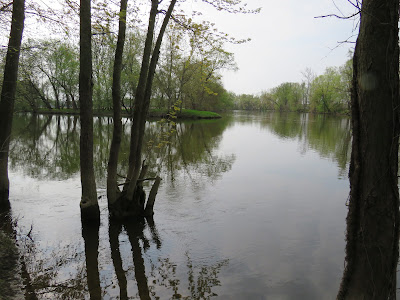It’s mid-morning near Ionia County’s village of Muir as I pause on a muddy bank to watch the Maple River flow from left to right and empty into the Grand River. Thus begins a new adventure as I hope to explore the natural environment of this meandering watercourse upstream. The Maple River is a 74-mile-long tributary of the Grand River flowing east to west through central Michigan. It begins in Shiawassee County, south of the city of Corunna and flows west through Clinton and Gratiot Counties before emptying into the Grand River where I stand. Other villages it flows through include Bannister, Ovid, Elsie and Maple Rapids. Part of its watershed make up the massive Maple River State Game Area. Also, from the muddy bank, I notice some Coyote tracks. The sky is partly sunny with temperatures in the upper 60’s as I hike along the riverside on the paved Meijer bike trail and pause to hear the steady, purring, mating calls of several male American toads. Up ahead, I spot a patch Trillium on my left and a floral combination on my right that includes, yellow Dandelion, pink Dead Nettle and white Garlic Mustard. Nearby, just off the trail, I notice a Catbird and a rarely-seen Lincoln’s Sparrow. John James Audubon named this bird after his travel companion Thomas Lincoln, who accompanied him on an expedition to the coast of Labrador. The expedition found the sparrow in a valley in Quebec, and Mr. Lincoln was the only person who managed to bring back a specimen for study. Continuing my hike, tree blossoms of Pin Cherry and Wild Cherry catch my eye. Turning my attention to the river, I see a couple of Painted Turtles basking on a log. Moving toward the car, I observe patches of Trout Lilly, Wood Anemone and Wild Geraniums. Finally, near the trailhead, I pause to look at a patch of Wild Ginger, with their distinctive kidney-shaped leaves. Stooping down, I lift one of the leaves to expose tiny, purple blossoms. This unusual growth is believed to have evolved to help early spring insects locate the flower for food and pollinating. Later, ants will carry seeds back to their colony where they will eat the fleshy nodules and discard the actual seed, which is then left to grow in the nutrient-rich plant waste underground. While it is not to be confused with the more common type of Ginger that is used to season food, there are still some recipes that call for using Wild Ginger as a spice substitute. Because of its antibiotic contents, Native Americans and early Euro-American settlers used it as a topical treatment for wounds.
Verdant banks
Muddy shore
New watercourse
For me to explore
Gentle current
Flowing corridor
Flora aplenty
Fauna galore
Not just a river
So much more
D. DeGraaf

No comments:
Post a Comment